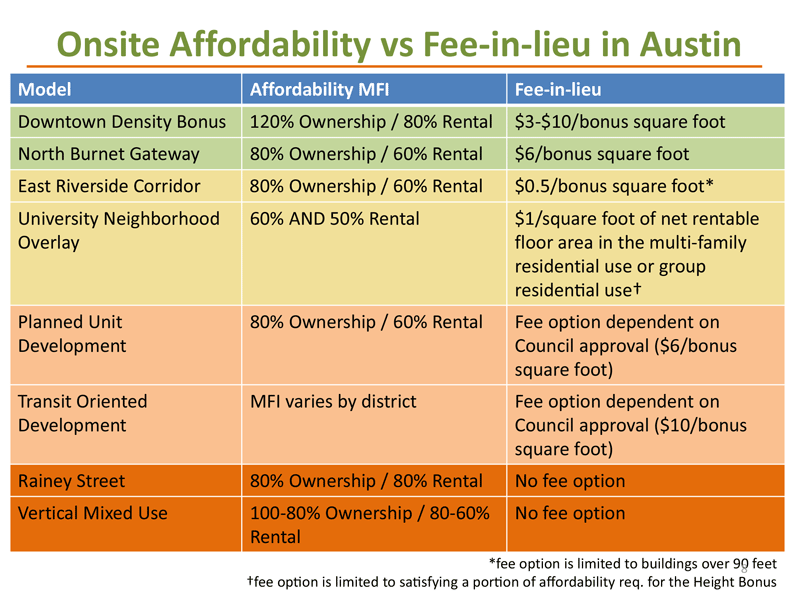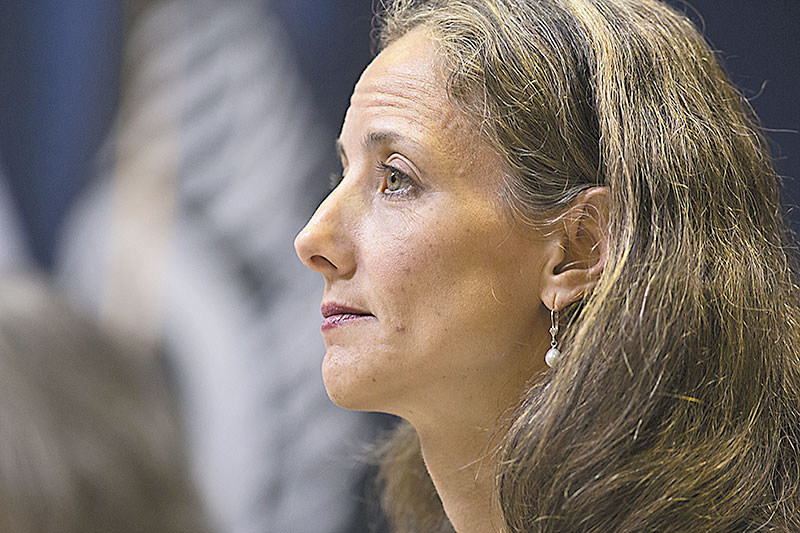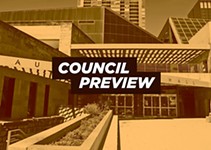Bonus Points for Affordability
CM Tovo proposes changes to city density bonus program
By Mary Tuma, Fri., Oct. 2, 2015

The juxtaposition of towering, luxury-priced buildings dominating the Austin skyline with the staggering need for affordable housing has fair-housing-minded city officials and community advocates grasping at any tools at their disposal to help lessen the burden for low-income families.
One such resource, the city's density bonus program (DBP) – crafted in part to widen affordable housing opportunities – could soon see changes supporters believe may better achieve that mission.
The idea behind the voluntary density bonus programs is to direct some of the dollars generated by new development across the city to poor residents seeking housing. If the city awards developers extra space to build, the logic goes, the public should get something back in return. So, if a private developer wants to build a denser project – more square footage or height – outside the bounds of what zoning code allows, they must, in exchange, provide community benefits, such as walkability, environmental concessions, and affordable housing. In most cases, developers can choose to build the cheaper housing on-site, or pay into a fund that supports affordable housing. For instance, in the North Burnet Gateway area, developers can pony up $6 per bonus square foot to be sent to a housing assistance fund, or else provide rental housing for households earning below 60% of the Median Family Income, or owned units for households earning below 80% of the MFI. Some housing advocates say the option not to build on-site could have the effect of exacerbating Austin's already well-documented housing segregation problem.
A resolution proposed by Mayor Pro Tem and District 9 Council Member Kathie Tovo aims to change that, among other things: It requests the city manager report back to City Council with information on the effectiveness of the bonus programs in generating affordable housing resources. The data is expected to show the total number of affordable units constructed; the longevity of affordability for each unit; all allocations of money generated by the fees-in-lieu; and a per-unit cost estimate for constructing each off-site unit using fee-in-lieu money. Those findings are intended to inform Council to decide if they should scrap or modify the fee-in-lieu option for some programs and require on-site affordable housing, the ultimate end goal for Tovo.

"We really have an affordable housing crisis in this community," said Tovo during a mid-August Planning and Neighborhood Committee meeting. As Austin is heavily restricted by state law (real-estate friendly Texas law limits inclusionary zoning), Tovo considers the DBP an important vehicle to promote housing for lower-income residents: "If we are serious about creating affordable housing in all parts of town, I believe we need to really look carefully at our density bonus programs and consider whether those wouldn't be more appropriate for units constructed on-site."
Additionally, there's a move to push Council to consider changing the affordable housing exemption currently allowed for commercial buildings Downtown, such as hotels and offices. In its early stages (and it's being tweaked), the resolution's timeline is still in the works. But broken off from Tovo's multi-part proposal and fast-tracked is a measure that directs the city manager to initiate a code change for the Multi Family-6 (MF-6) "loophole" that developers opt for instead of Vertical Mixed Use (VMU) zoning, which requires on-site affordability, and to bring that code amendment to Council no later than Oct. 15.
The overall resolution ultimately passed 3-1, winning approval from Committee Chair Greg Casar and CM Pio Renteria, with conservative-leaning Sheri Gallo dissenting (not because she is against affordable housing, she stressed, but because she wanted more time to digest it amid budget hearings).
"It's been a longstanding priority of mine to eliminate the fee-in-lieu ability because it is set at such a rate that it's always cheaper to pay the fee than to construct the housing," Tovo tells the Chronicle. To contrast with a comparable city: Austin's Downtown bonus program offers $3-10 per square foot of bonus area, whereas Seattle's program charges nearly $23 per square foot of bonus area for residential properties.
The Bonus of Density
On the flip side, developers have long argued that density is a community asset itself. Building up and building tall (rather than scattered single-family homes) leads to less sprawl and more taxable property, which in turn can be spent on city services, including low-cost housing. "The density developers are offered is something that is not sufficient to offset the cost of the affordable units, especially when some of us would argue density itself in the right places is its own benefit to the community," said Heidi Gerbracht, the Real Estate Council of Austin's vice president of public policy, during the August committee hearing. "Fee-in-lieu is not a losing proposition in our mind." Gerbracht expands on her point by raising concern about the feasibility of constructing affordable on-site units amid escalating development costs that go into building tall: "You cannot believe in any rational way that those costs don't get passed down to the consumer. Things in Austin are just more expensive now and there just has to be more incentive for developers. There needs to be more give from the city for the get," she tells the Chronicle.
Yet for those fighting to create a robust affordable housing market, on-site residential units in all areas can help combat housing segregation and help fill the housing void. Roughly 60,000 renter households earn less than $25,000 per year, with just 19,000 affordable rental units to serve them, leaving a shortage of 41,000 units, according to a 2014 Comprehensive Housing Market Analysis conducted by BBC Research & Consulting. And low- to moderate-income renters are scrambling to secure housing amid increased competition for non-luxury units. Writing that the city "can do more" to encourage developers to stimulate affordable housing options, the study recommended the city's density bonus programs could modify affordability targets, like lowering MFI for rental units to match current needs; raise the fee-in-lieu rates to a price "comparable to what it costs a developer to build, market, and rent or sell an affordable unit"; and build larger affordable units to accommodate low-income families.
"Austin has a long history of housing segregation, and the density bonus program is one of the best tools we have for creating integrated and inclusive communities," says Heather Way, UT Law professor and longtime affordable housing policy advocate. Indeed, the decades-old divide has deep roots that have yet to be fully bridged: A 2015 study by the Martin Prosperity Institute rated Austin-Round Rock as the most economically segregated large metro area in the country. "Overall it's great to make a move toward requiring on-site affordable housing, especially when that housing is located in a high-opportunity area. The problem with the fee-in-lieu option is that it's so easy to take because they're set, by and large, low. So the developer is rarely going to have an economic incentive to build on-site when they have that option available."
Indeed, that appears to be the case, at least Downtown: All three projects that opted into the Downtown density bonus program (Eighth and Nueces; Fifth and West; and Seventh and Congress) have chosen the fee-in-lieu option, says Jorge Rousselin, an urban design project manager with the city. However, some in the affordable housing community aren't opposed to developers taking that route in the city's center, since those funds are earmarked for Housing First permanent supportive housing for Austin's homeless.

Finding the Magic Amount
Ann Howard, executive director of the Ending Community Homelessness Coalition (ECHO), is keenly aware of the delicate balance Council must strike when crafting a new plan. "Everyone's concern should be figuring out what's the magic amount that's not going to deter developers from choosing density," she says. "So we need to encourage density to address the housing gap, but we don't want any negative, unintended consequences by raising the fee too high, because in the end we'll get neither." Tovo has pledged to deeply consider Howard's concerns moving forward. "I take seriously the comments from groups like ECHO who say the fee will serve a valuable need," she says. "So I'm going to continue to be supportive of the fee-in-lieu for Downtown, but I want to recalibrate the fee to make it equivalent to what it would cost to construct housing on-site." Right now, the financial support for the city's unsheltered still has yet to reach the hands of ECHO. Less than two years in progress, the Downtown density bonus program's fee-in-lieu funds will only flow to homeless housing when construction is complete, so likely sometime right before 2017. "We've never seen the money," says Howard.
While a long public debate is sure to follow in the coming weeks, Tovo reiterates the importance of using programs already in motion to create a more equitable housing landscape. "I believe we are at a critical place in Austin, and there is a strong desire within the community to see things more affordably priced in all parts of town, not just isolated in one area," she says. "And one way to do that is to require those units be constructed on-site in areas where there are good schools, good access to transit, good businesses and other services that reduce the costs for families."
"Austin is rapidly becoming a place where some neighborhoods are very wealthy and some are not, so we need to achieve a better balance."
Got something to say on the subject? Send a letter to the editor.











